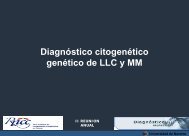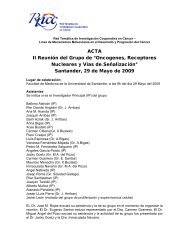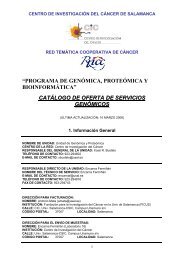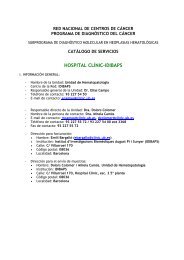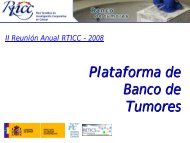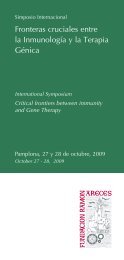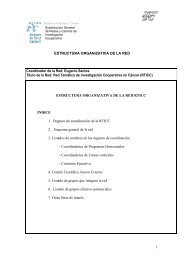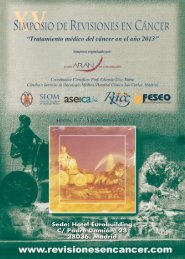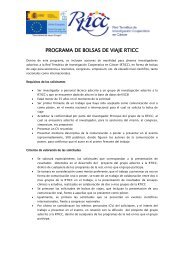Untitled - Red Temática de investigación cooperativa en cáncer
Untitled - Red Temática de investigación cooperativa en cáncer
Untitled - Red Temática de investigación cooperativa en cáncer
Create successful ePaper yourself
Turn your PDF publications into a flip-book with our unique Google optimized e-Paper software.
P-39<br />
NOVEL IDENTIFICATION OF EXOSOMES IN UTERINE ASPIRATES AND ITS<br />
UTILITY AS A SOURCE FOR NEW BIOMARKERS<br />
CAMPOY I 1 , MARTÍNEZ GARCÍA E 1 , DEVIS JAUREGUI L 1 , GARCÍA A 1 , CASTELLVÍ J 1 , CABRERA S 1 ,<br />
GIL-MORENO A 1 , ABAL M 2 , REVENTÓS J 1 , COLÁS E 1<br />
1<br />
HOSPITAL VALL D´HEBRÓN, BARCELONA (RD06/0020/0058)<br />
2<br />
CHUS, SANTIAGO DE COMPOSTELA<br />
Background and aim: Exosomes are 40-100 nm extracellular vesicles released from a<br />
variety of cell types. Our aim is to use exosomes as a source to i<strong>de</strong>ntify new s<strong>en</strong>sitive and<br />
specific biomarkers for the <strong>de</strong>tection of <strong>en</strong>dometrial cancer through a non-invasive method,<br />
isolating them from the uterine aspirate, which is the nearest and the easiest-to-access<br />
body fluid in contact with the <strong>en</strong>dometrium. To date, reports on exosomes coming from<br />
uterine aspirates remain un<strong>de</strong>scribed.<br />
Methods: We standardized the protocol for the isolation of exosomes (both from uterine<br />
aspirates and from media of cancer cell lines in culture) by ultrac<strong>en</strong>trifugation-based techniques;<br />
we characterized them by electron microscopy and immunoblot. We performed a<br />
pilot study by LC-MS/MS isolating, quantifying, digesting and analyzing its protein fraction.<br />
Computational analysis was performed by using Ing<strong>en</strong>uity Pathways Analysis.<br />
Results: Membrane-vesicles were observed in uterine aspirates by electronic microscopy<br />
by negative staining. Also, western blot analysis of the isolated exosomes revealed the pres<strong>en</strong>ce<br />
of known exosome markers, such as CD81, TSG-101 and other membrane proteins,<br />
such as Annexin 2, both in uterine aspirates and cultured cell lines. LC-MS/MS analysis<br />
<strong>en</strong>abled the i<strong>de</strong>ntification of 153 proteins in the uterine aspirate exosomes. From the list of<br />
proteins i<strong>de</strong>ntified, we recognized several proteins that belong to the exosome biog<strong>en</strong>esis<br />
and also <strong>en</strong>dometrial cancer related proteins. IPA analysis i<strong>de</strong>ntified Cellular Movem<strong>en</strong>t,<br />
Immune Cell Trafficking, Cell-To-Cell Signaling and Interaction as the top networks, Cancer<br />
as the top disease by Bio Function classification and Cell-To-Cell Signaling and Interaction<br />
as the top Molecular and Cellular Function.<br />
Conclusion: Our data <strong>de</strong>monstrates that the i<strong>de</strong>ntification of the protein cont<strong>en</strong>t of exosomes<br />
isolated from uterine fluids is feasible and promising for the i<strong>de</strong>ntification of critical<br />
molecules involved in <strong>en</strong>dometrial cancer, which can be used as diagnostic markers.<br />
P-40<br />
INHIBITORY MECHANISMS OF THE RESPONSE TO TGF-B BY THE THYROID<br />
HORMONE RECEPTORS<br />
ALONSO MERINO E 1 , MARTIN OROZCO R 1 , RUIZ LLORENTE L 1 , FANJUL RODRIGUEZ LF 1 , MARTI-<br />
NEZ IGLESIAS O 1 , ARANDA IRIARTE A 1<br />
1<br />
INSTITUTO DE INVESTIGACIONES BIOMÉDICAS “ALBERTO SOLS”, MADRID (RD06/0020/0036)<br />
The thyroid hormone receptors, <strong>en</strong>co<strong>de</strong>d by the TRα and TRβ g<strong>en</strong>es, are ligand-<strong>de</strong>p<strong>en</strong><strong>de</strong>nt<br />
transcription factors that belong to the nuclear receptor superfamily, being the 3,5,3’-triiodothyronine<br />
(T3) their main ligand. In addition to the role of these receptors in growth,<br />
<strong>de</strong>velopm<strong>en</strong>t and metabolism, there is increasing evi<strong>de</strong>nce that they can also inhibit transformation<br />
and act as tumor suppressors.<br />
We now have analysed the possibility that TRs could block responses to the transforming<br />
growth factor beta (TGFβ). This regulatory cytokine exerts tumor-suppressive effects in<br />
normal cells, but on the other hand, cancer cells eva<strong>de</strong> this repression and TGFβ can promote<br />
some tumorog<strong>en</strong>ic processes such as cell proliferation, cell invasion, immune regulation<br />
and micro<strong>en</strong>vironmet modification.<br />
In this work we <strong>de</strong>monstrate that TR, activated by T3 binding, can block transactivation<br />
by TGFβ of reporter plasmids containing a Smad Binding Elem<strong>en</strong>t (SBE) and repress transcription<br />
of <strong>en</strong>dog<strong>en</strong>ous TGFβ target g<strong>en</strong>es. We have also <strong>de</strong>monstrated that transfection<br />
of Smad transcription factors stimulate the activity of the reporter plasmid in the abs<strong>en</strong>ce<br />
of TGFβ, and that T3 inhibits this activation. In immunofluoresc<strong>en</strong>ce assays we have se<strong>en</strong><br />
that reversion of the TGFβ response is not mainly due to inhibition of Smads translocation<br />
to the nucleus. However, in chromatin immunoprecripitation assays (ChIP), we have observed<br />
that T3 inhibits TGFβ–<strong>de</strong>p<strong>en</strong><strong>de</strong>nt recruitm<strong>en</strong>t of Smads to target g<strong>en</strong>es promoters<br />
containing SBEs.<br />
In addition, T3 reduces acetylated histones and increases histone <strong>de</strong>cetylase 3 (HDAC3)<br />
recruitm<strong>en</strong>t to TGFβ target g<strong>en</strong>es. The hormone is also able to block TGFβ-<strong>de</strong>p<strong>en</strong><strong>de</strong>nt<br />
proliferation and migration. These results <strong>de</strong>monstrate that T3 blocks transcriptional responses<br />
to TGFβ, and suggest that some of the anti-tumorig<strong>en</strong>ic and anti-invasive actions of<br />
the thyroid hormone receptors can involve repression of the activity of the TGFβ signalling<br />
pathway.<br />
84 85



